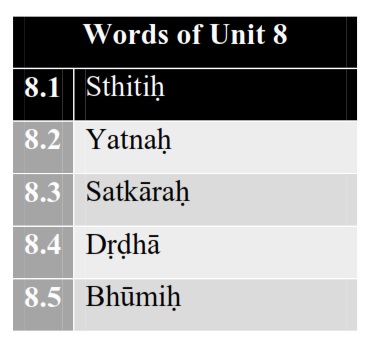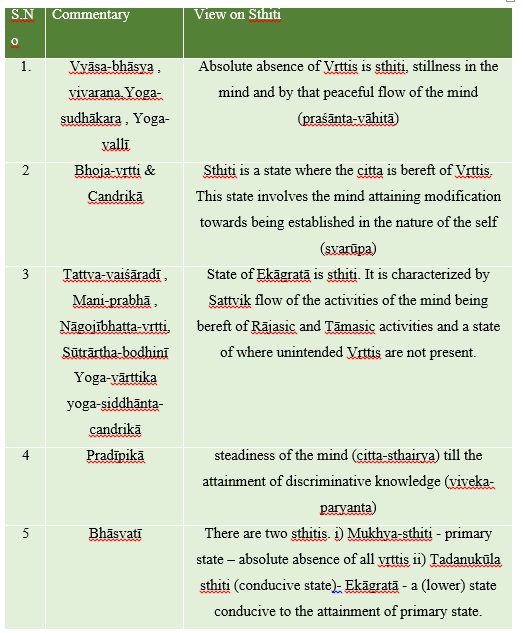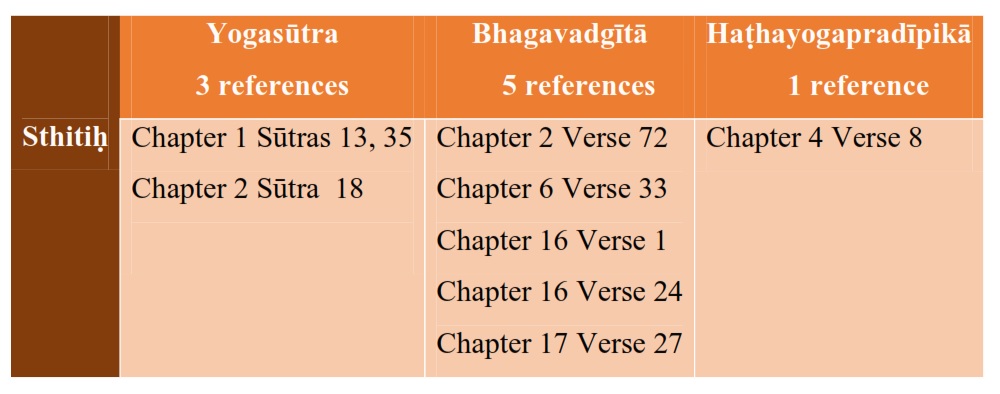Introduction
In this series, Yogic terminologies will be taken up and their –
- Etymological analysis,
- Lexical descriptions and
- Textual occurrences in Yogic literature and their commentaries, as available, will be presented. And finally observations will be made on the references.
Three texts – Yogasūtra, Haṭha-yoga-pradīpikā and Bhagavad-gītā are consulted for textual occurrences portion.
Śabda-yoga is intended to help students, teachers, and professionals of Yoga to develop a sound grammatical, contextual, and thereby an authentic and immersive understanding of Yoga terminologies.
List of Words
In the previous unit words from the Sūtra 1.10, 11 and 12 were taken up. In this Unit we will take up important Yogic terms from Sūtras 1.12 & 13.
The terms that will be analyzed in this Unit are –
Though, terms such as Tatra, dīrghakāla, nairantarya, āsevitaḥ are part of the Sūtras, still they are not take up as they are simple terms used in their general sense and also not prevalently used in Yoga context.
8.1 Sthitiḥ
Etymology
ष्ठा + क्तिन् = स्थितिः
ṣṭhā + ktin = sthitiḥ
- ष्ठाṣṭhā is the root which means गतिनिवृत्ति gatinivṛtti – absence of movement
- क्तिन्ktin is the suffix that indicates भावBhavā – the act. This is based on the Pāṇiniyan rule स्त्रियांक्तिन् striyāṃ ktin (aṣṭādhyāyī 3.3.94)
Based on the etymology, the derivative statement would be – स्थीयतेइतिस्थितिः – sthīyate iti sthitiḥ – the act of non-movement
Lexicon
There are two entries in Amarakośa. They are as follows –
मर्यादाधारणास्थितिः2.8.26.
maryādā dhāraṇā sthitiḥ
maryādā dhāraṇā sthiti are used to indicate limit.
स्यादास्यात्वासनास्थितिः3.2.21.
syādāsyātvāsanā sthitiḥ
āsyā, āsanā, sthiti are the words that mean – being seated.
Though lexicon gives two interesting meanings limit and being seated, these meanings are not seen to be applicable in the context of Yogasūtra 1.13.
Textual Occurrences
Yogasūtra
There are three occurrences of the term Sthiti in this text. They are as follows –
1) तत्रस्थितौयत्नाऽभ्यासः॥१.१३॥
tatra sthitau yatnā’bhyāsaḥ .. 1.13 – This Sūtra defines abhyāsa, one among the twin tools to attain Citta-vritti-nirodha (cessation/restraint of activities of the mind). The effort to attain sthiti is defined as abhyāsa by Sage Patañjali.
The following table gives the details about the various views of traditional commentators on this very crucial term.
Source: Mahadevan J. Sthiti and Yatna in the abhyāsa of Yoga: A textual study based on 15 Saṃskṛta commentaries of Yogasūtra. Yoga Mimamsa 2021;53:122-8
2) विषयवतीवाप्रवृत्तिरुत्पन्नामनसःस्थितिनिबन्धनी॥१.३५॥
viṣayavatī vā pravṛttirutpannā manasaḥ sthitinibandhanī .. 1.35 .. – This Sūtra describes a Yogic method called viṣayavatī pravṛtti by which the sthiti – or stability of the mind shall be ensured in the object of focus. Here the word Sthiti refers to non-distracted, stable, steady state of mind. This is agreed by most commentators.
3) प्रकाशक्रियास्थितिशीलंभूतेन्द्रियात्मकंभोगापवर्गार्थंदृश्यम्॥२.१८॥
prakāśakriyāsthitiśīlaṃ bhūtendriyātmakaṃ bhogāpavargārthaṃ dṛśyam .. 2.18 .. – This Sūtra describes the dṛśya – the object seen by the consciousness. This kind of seen object exhibits three qualities – prakāśa – light/knowledge, kriyā – action and sthiti-absence of movement/inertia. The commentators note that these three attributes are expression of the three Guṇas namely Sattva, Rajas and Tamas.
Bhagavadgītā
There are five occurrences of the term sthiti and its close derivatives in Bhagavadgītā.
1) एषाब्राह्मीस्थितिःपार्थनैनांप्राप्यविमुह्यति।
स्थित्वास्यामन्तकालेऽपिब्रह्मनिर्वाणमृच्छति॥२.७२॥
eṣā brāhmī sthitiḥ pārtha naināṃ prāpya vimuhyati .
sthitvāsyāmantakāle’pi brahmanirvāṇamṛcchati .. 2.72 .. – This is the last verse in the second chapter. The word sthiti – is used to denote state and it has an adjective – brāhmī – associate to Brahman.
Ācārya Śaṅkara Bhagavatpāda describes brāhmī sthitiḥ as ब्रह्मरूपेणैवअवस्थानम् brahmarūpeṇaiva avasthānam – to be established in the form of Brahman itself- which is attained by control of the senses and by becoming sthita-prajña.
2) योऽयंयोगस्त्वयाप्रोक्तःसाम्येनमधुसूदन।
एतस्याहंनपश्यामिचञ्चलत्वात्स्थितिंस्थिराम्॥६.३३॥
yo’yaṃ yogastvayā proktaḥ sāmyena madhusūdana .
etasyāhaṃ na paśyāmi cañcalatvātsthitiṃ sthirām .. 6.33 .. – These are the words of Arjuna in the sixth chapter. Here he doubts that whether the teachings of Kṛṣṇaon meditation can be followed at all. He feels that the Yoga taught by Kṛṣṇa is difficult to follow because – he says “as I do not see the stable state (sthitiṃ sthirām) because it is fickle”.
3) अभयंसत्त्वसंशुद्धिर्ज्ञानयोगव्यवस्थितिः।
दानंदमश्चयज्ञश्चस्वाध्यायस्तपआर्जवम्॥१६. १॥
abhayaṃ sattvasaṃśuddhirjñānayogavyavasthitiḥ .
dānaṃ damaśca yajñaśca svādhyāyastapa ārjavam .. 16. 1 .. – this is the first verse of the 16th Chapter on divine and demonic qualities. Here, the first verse describes the divine qualities. Among them the expression jñāna-yoga-vyavasthitiḥ is also found. Vyavasthiti –is an associated term of sthiti, which is now being explored. Ācārya Śaṅkara Bhagavatpāda while commenting upon the this expression states that – ज्ञानंशास्त्रतःआचार्यतश्चआत्मादिपदार्थानाम्अवगमः, अवगतानाम्इन्द्रियाद्युपसंहारेणएकाग्रतयास्वात्मसंवेद्यतापादनंयोगः, तयोःज्ञानयोगयोःव्यवस्थितिःव्यवस्थानंतन्निष्ठता -jñānaṃ śāstrataḥ ācāryataśca ātmādipadārthānām avagamaḥ, avagatānām indriyādyupasaṃhāreṇa ekāgratayā svātmasaṃvedyatāpādanaṃ yogaḥ, tayoḥ jñānayogayoḥ vyavasthitiḥ vyavasthānaṃ tanniṣṭhatā
Knowledge – Jñāna – refers to the knowledge about Ātman and associated principles attained from the śāstratas and the Ācārya. Yoga refers to making those principles self-evident by single pointed focus. Vyavasthiti – refers to being committed and dedicated to such cause of Jñāna and Yoga. It very interesting to note that by addition of the prefixes vi and ava – the meaning expression sthiti – becomes being dedicated.
4) तस्माच्छास्त्रंप्रमाणंतेकार्याकार्यव्यवस्थितौ।
ज्ञात्वाशास्त्रविधानोक्तंकर्मकर्तुमिहार्हसि॥१६.२४॥
tasmācchāstraṃ pramāṇaṃ te kāryākāryavyavasthitau .
jñātvā śāstravidhānoktaṃ karma kartumihārhasi .. 16.24 .. – As earlier, the word Vyavasthiti is used. Interestingly the word Vyavasthiti means discernment. From the context of the verse it could be seen that – Vyavasthiti – refers to discernment of what has to be done and what to be avoided. Ācārya Śaṅkara Bhagavatpāda comments upon the word Vyavasthiti as vyavasthā – just a synonym of the same expression.
5) यज्ञेतपसिदानेचस्थितिःसदितिचोच्यते।
कर्मचैवतदर्थीयंसदित्येवाभिधीयते॥१७. २७॥
yajñe tapasi dāne ca sthitiḥ saditi cocyate .
karma caiva tadarthīyaṃ sadityevābhidhīyate .. 17. 27 .. – Here the word Sthiti indicates being rooted. Being root in the practice of Yajña, tapas and dāna are term as Sat – noble. Though Ācārya Śaṅkara Bhagavatpādadoes not comment upon the word Sthiti here, this meaning emerges contextually.
Haṭhayogapradīpikā
There is just one occurrence of sthiti in this text. It is as follows –
राजयोगस्यमाहात्म्यंकोवाजानातितत्त्वतः।
ज्ञानंमुक्तिःस्थितिःसिद्धिःगुरुवाक्येनलभ्यते॥४.८॥
rājayogasya māhātmyaṃ ko vā jānāti tattvataḥ .
jñānaṃ muktiḥ sthitiḥ siddhiḥ guruvākyena labhyate .. 4.8 .. – This verse from the fourth chapter and it states about the greatness of Rājayoga. Jñāna, mukti and sthiti which are all part of Rājayoga are attained by the words of the Guru.
In this context the word sthiti has been explained by the Jyotsnā commentary as – स्थितिःनिर्विकारस्वरूपावस्थितिरूपा- sthitiḥ nirvikārasvarūpāvasthitirūpā – the unchanging establishment (of the mind) in the true nature of consciousness.
Tabulation of Textual References 8.1
The etymological meaning conveys absence of movement or change. In the Yogic context this word assumes various connotations
1) Sthiti – depending upon the context of usage may point to – non flickering, non-fluctuating nature of the mind which can either be single pointed focus or establishment in the true nature of the consciousness. Especially the word sthiti with the adjective Brahmī, in the Bhagavadgītā, indicates being established in the nature of Brahman itself. Haṭhayogapradīpikā also agrees with the meaning of unchanging establishment of the mind in the form of the consciousness.
2) sthiti – lack of movement in the senses and the elements –points to expression of Tamas in them.
3) Sthiti, contextually, also points to be meaning being rooted (in practice of Yajña, Dāna & Tapas).
4) The word sthiti with prefixes vi and ava again gains two meanings contextually – dedication and discernment
Thus these various shades of meanings of the mere word sthiti, with adjectives and prefixes points the significance of the term and also underlines the care that needs to be taken in interpreting and imparting it in the context of Yoga.This activity of śabdayoga has been useful in bringing out these various shades of meanings.
Useful Links
Archive of previous Śabdayoga Entries – https://yoga-words-demystified.blogspot.com/2022/01/sabda-yoga-language-of-yoga-demystified.html
Video Explanation of Śabdayoga (Playlist) – https://www.youtube.com/playlist?list=PLHwsf77PLjWvmryW-f0z2hLAHmzaRbKnX
References
- Advaitaśāradā – https://advaitasharada.sringeri.net/
- Amarakoṣasampat – http://amara.aupasana.com/
- Aṣṭādhyāyī – https://ashtadhyayi.com/
- Aksharamukha – https://aksharamukha.appspot.com/
- Avyayakośaḥ, śrīśrīvatsāṅkācāryaḥ, saṃskṛtavidyāsamitiḥ, chennai, 2004
- Gītā Supersite – https://www.Gītāsupersite.iitk.ac.in/
- Nāmaliṅgānuśāsana alias amarakoṣa of amarasiṃha with the commentary vyākhyāsudhā or rāmāśramī by bhānuji dīkṣita, Edited with notes by M.M.Pandit Shivadatta Dadimatha, Chaukhamba Saṃskṛta Prathisthan, Delhi, Reprint 2002
- śabdārthakaustubha, cakravartī śrīnivāsagopālācārya, Vol 4, Bappco Publication, Bengaluru, Reprint 2009
- Yoga-vaiśāradī – https://kymyogavaisharadi.org/
Unit 8 To be Continued…
Disclaimer: The opinions expressed in this article belong to the author. Indic Today is neither responsible nor liable for the accuracy, completeness, suitability, or validity of any information in the article.














